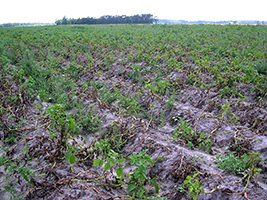
Late Blight of Potato:
History and Importance:
- Most destructive*(economic and social impact) disease of potato
- In 1845 destroyed large area in Europe (Ireland). Great Irish Famine
- Large No. of people died, remaining migrated
Etiology:
Causal organism: Phytophthora infestans
Order: Peronosporales
Family: Pythiaceae
Symptoms:
- On leaves and stem dark brown or black dead lesion*(injury/wound) appear
- Blighted areas appear as faded green patches
- In moist conditions decay giving offensive smell
- Dead areas started from tip or margins
- In severe attack tubers skin give black discoloration
- White sporulation appears on lower surface of leaves.
- Infected tuber tissues are copper brown, reddish or purplish in color.
Disease cycle:
- Pathogen survive from season to season in infected tubers in field or through contaminated seeds
- Secondary spread is through wind, water & leaf eating insects.
- Potato tubers can become infected in the field when sporangia are washed from lesions on the foliage and enter into the soil.
- Infections generally begin in tuber cracks, eyes or lenticels.
Epidemiology:
- 12-13°C temp.
- more than 90 % RH
Management:
- Seed tubers selected from healthy field
- Sanitation: weeding for low humidity
- Tuber treatment with mercuric chloride (1:1000)
- High ridging as 15 cm*(because low lying areas conserve more moisture that favors pathogen growth).
- Irrigation time should be adjusted in such a way that don’t extend the night dew duration.
- Store in potato tubers in dry & well aerated place.
- Spray with systemic fungicides (dimethomorph, Cymoxanil, fluopicolide).
- Hilling: Covering of newly emerged plant at the base*(helps in early weed control and avoid from direct water contact).


